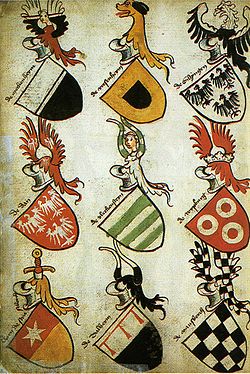

A roll of arms (or armorial) is a collection of coats of arms, usually consisting of rows of painted pictures of shields, each shield accompanied by the name of the person bearing the arms.
Contents
- Notable examples
- Medieval
- Early Modern
- Modern
- References
- Roll identification numbers
- Sources
- External links
The oldest extant armorials date to the mid-13th century, and armorial manuscripts continued to be produced throughout the early modern period. Siebmachers Wappenbuch of 1605 was an early instance of a printed armorial. Medieval armorials usually include a few hundred coats of arms, in the late medieval period sometimes up to some 2,000. In the early modern period, the larger armorials develop into encyclopedic projects, with the Armorial général de France (1696), commissioned by Louis XIV of France, listing more than 125,000 coats of arms. In the modern period, the tradition develops into projects of heraldic dictionaries edited in multiple volumes, such as the Dictionary of British Arms in four volumes (1926–2009), or J. Siebmacher's großes Wappenbuch in seven volumes (1854–1967).
Armorials can be "occasional", relating to a specific event such as a tournament; "institutional", associated with foundations, such as that of an order of chivalry, "regional", collecting the arms of the nobility of a given region, "illustrative", in the context of a specific narrative or chronicle, or "general", with the aim of an encyclopedic collection. [2] A roll of arms arranged systematically by design, with coats featuring the same principal elements (geometrical ordinaries and charges) grouped together as a tool to aid identification, is known as an ordinary of arms (or simply as an ordinary).




![Presentation miniature in the Armorial of Gilles Le Bouvier [fr] showing herald Gilles Le Bouvier kneeling, giving his book to Charles VII of France. Armorial de Gilles Le Bouvier - BNF Fr.4985 f13v - Frontispice (cropped).jpg](http://upload.wikimedia.org/wikipedia/commons/thumb/3/36/Armorial_de_Gilles_Le_Bouvier_-_BNF_Fr.4985_f13v_-_Frontispice_%28cropped%29.jpg/330px-Armorial_de_Gilles_Le_Bouvier_-_BNF_Fr.4985_f13v_-_Frontispice_%28cropped%29.jpg)
